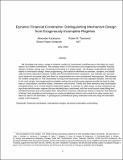Dynamic Financial Constraints: Distinguishing Mechanism Design From Exogenously Incomplete Regimes
Author(s)
Karaivanov, Alexander; Townsend, Robert
DownloadDynamicFinancialConstraints.pdf (1.457Mb)
OPEN_ACCESS_POLICY
Open Access Policy
Creative Commons Attribution-Noncommercial-Share Alike
Terms of use
Metadata
Show full item recordAbstract
We formulate and solve a range of dynamic models of constrained credit/insurance that allow for moral hazard and limited commitment. We compare them to full insurance and exogenously incomplete financial regimes (autarky, saving only, borrowing and lending in a single asset). We develop computational methods based on mechanism design, linear programming, and maximum likelihood to estimate, compare, and statistically test these alternative dynamic models with financial/information constraints. Our methods can use both cross-sectional and panel data and allow for measurement error and unobserved heterogeneity. We estimate the models using data on Thai households running small businesses from two separate samples. We find that in the rural sample, the exogenously incomplete saving only and borrowing regimes provide the best fit using data on consumption, business assets, investment, and income. Family and other networks help consumption smoothing there, as in a moral hazard constrained regime. In contrast, in urban areas, we find mechanism design financial/information regimes that are decidedly less constrained, with the moral hazard model fitting best combined business and consumption data. We perform numerous robustness checks in both the Thai data and in Monte Carlo simulations and compare our maximum likelihood criterion with results from other metrics and data not used in the estimation. A prototypical counterfactual policy evaluation exercise using the estimation results is also featured.
Date issued
2014-05Department
Massachusetts Institute of Technology. Department of EconomicsJournal
Econometrica
Publisher
John Wiley & Sons, Inc/Econometric Society
Citation
Karaivanov, Alexander and Robert M. Townsend. “Dynamic Financial Constraints: Distinguishing Mechanism Design From Exogenously Incomplete Regimes.” Econometrica 82, no. 3 (2014): 887–959.
Version: Original manuscript
ISSN
0012-9682
1468-0262